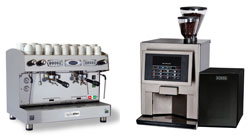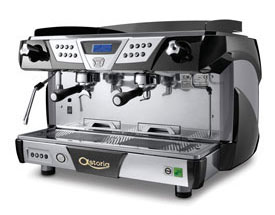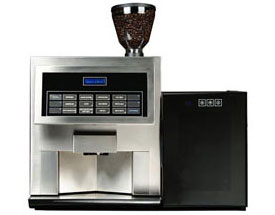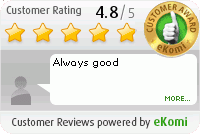Coffee Machine Guide
Which type of commercial coffee machine would best suit your business?

There are many different varieties of coffee machines available, each with their own advantages and disadvantages, it can be a daunting decision when deciding on what coffee machine is the best fit for your business.
But by looking at the individual strengths and weaknesses of each type of machine — espresso machines and bean to cup machines — you can you make an informed decision on which type is best for your unique circumstances or requirements.
The aim of this section is to help explain the major differences between the two main coffee machines used in a commercial environment: espresso and bean to cup.
Why just those two?
The espresso is the base of almost all coffees. Short, sharp and highly concentrated, an espresso is produced by passing hot water through the tightly packed ground coffee at a pressure of around 9bar.
The resulting drink can be consumed on its own, or blended with hot water, milk and a variety of other ingredients to create Cappuccinos, Americanos, Lattes and a multitude of speciality beverages.
Others may be able to make a coffee, but if coffee is going to be a core product within your business then the choice will likely be between an automatic bean to cup or a barista-operated traditional espresso machine
Espresso or Bean to Cup?
So you have settled upon selling coffee as a core product, but before deciding which specific machine to choose it is time to determine which option is best for your specific scenario.
Five reasons to choose an espresso machine
- Coffee is going to be focal point of your business
- You want to produce the best coffee possible
- Presentation, style and tradition is important
- Busy periods are expected where multiple drinks will be required quickly
- You aren’t a traditional static seller
Five reasons to choose bean to cup coffee machine
- Ease of use is important
- Staff turnover is high, hence training is difficult
- Coffee, whilst important, isn't a primary focus of your business
- Self-service will be required
- Staff will need to multi-task
Let’s look into the differences in a bit more detail:
| Traditional | |
|---|---|
| Example Image: |

|
| Drink Quality | Excellent, providing the barista is well trained. |
| Ease of Use |
Training is required, but once taught they are very easy to use |
| Example process: |
|
| Consistency: | Dependent upon the skill of the barista |
| Theatre: |
Espresso machines enhance the aesthetics of the establishment and baristas can entertain and talk while preparing drinks, providing a better customer experience |
| Training: |
It is important the Barista controls the coarseness / fineness of the ground coffee, and that the correct amount of pressure is applied when tamping. There is also skill involved in foaming milk correctly. |
| Cleaning: | A simple backflush procedure and wipe down at the end of every day Wipe and sterilise steam arms regularly during use |
| Suitable for Self Service? | No, operators must be trained to use the machines |
| Suitable for a Mobile Business? | Yes, dual fuel espresso machines are available and provide an attractive option for mobile caterers |
| Bean to Cup | |
|---|---|
| Example Image: |

|
| Drink Quality | Very good, providing machine is cleaned and maintained. |
| Ease of Use |
Simple: the operator presses a button |
| Example process: |
* ie: the machine will grind and compress the beans, brew and pour the espresso, steam the milk and dispense it into a cup. |
| Consistency: | Very - providing machine is cleaned and properly maintained of course. |
| Theatre: |
There is no real theatrical value in bean to cup machines due to their functional nature |
| Training: | Staff training required for cleaning. |
| Cleaning: | Cappuccino and milk system must be cleaned daily. Milk frothers and valves need soaking and cleaning regularly. Coffee clean required regularly |
| Suitable for Self Service? | Yes. Some machines can even be fitted with coin mechanisms for self service vending |
| Suitable for a Mobile Business? | No, the number of mechanical and electronic parts make them unsuitable for mobile use |
The major difference between the two types of machine is the amount of coffee that each is able to make. Espresso machines are designed for continuous use and can produce multiple cups of coffee at the same time.
A bean to cup coffee machine is limited to a certain number in a day, this is in part due to intricate components that are unable to be in operation for continuous periods.
Other ways
We understand that not every environment is suitable for a bean to cup or a traditional machine and, in some instances, an additional type of equipment or brewing method may also be required.
Further options include:
- Filter coffee machines
- Bulk brew coffee machines
- Single-serve coffee machines
- Instant coffee machines
- Specialised brewing equipment, drippers and filter papers

